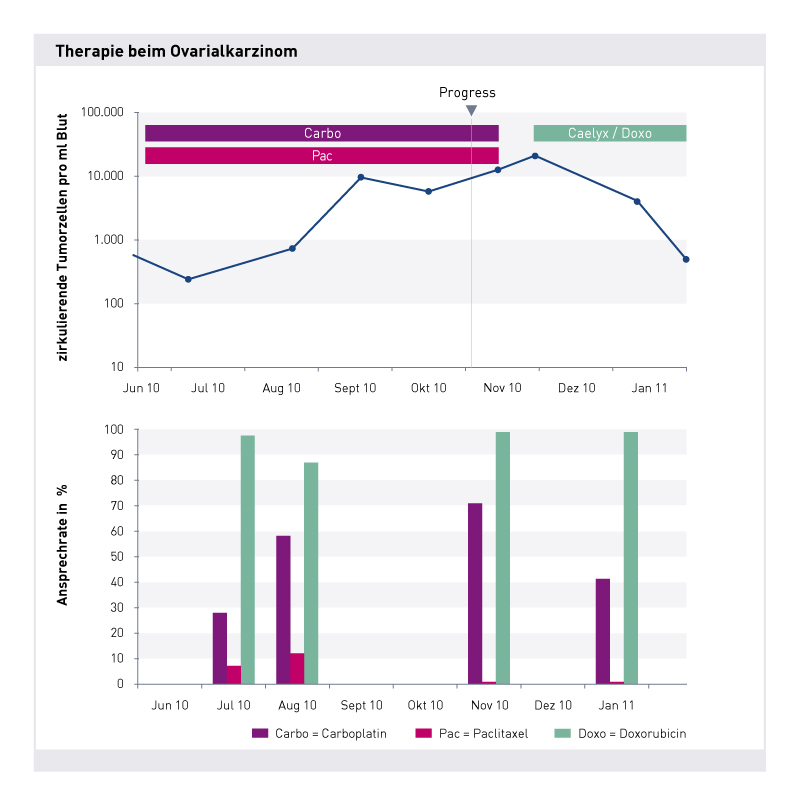A metastatic situation is characterized by the presence of secondary tumors (metastases) alongside the primary tumor. This is a scenario where treatment can be more complex, and the interpretation of cell count trends must be considered very individually.
CTCs are released into the blood both from the primary tumor and the metastases. To target all metastases, systemic therapies are typically employed to reduce CTCs, metastases, and the primary tumor. Here, maintrac can assist in selecting the most individually effective medication for the patient.
However, in cases of a metastatic situation, we recommend using the stemtrac® test, which quantifies only the „more aggressive“ tumor stem cells.
Medication Testing
To identify the most effective therapy, testing the cytotoxicity of different chemotherapeutic agents is recommended. Subsequently, closely monitoring the disease’s progress through cell count tracking is crucial.
Due to the various interpretation possibilities, maintrac® cell count trends or stemtrac® measurements in the metastatic situation need to be considered very individually. Therefore, doctors should ideally submit comprehensive treatment protocols along with blood samples. This will provide the best assessment of the therapy situation.
Metastatic Situation – Special Behavior of CTCs
The initial measurement of the maintrac® cell count is always just a baseline, which by itself has limited significance. Only the trend of cell count, which emerges after at least one more measurement, can be interpreted.
In the image on the right, you can observe medication testing. In this case, Carboplatin and Paclitaxel were administered according to guidelines; however, medication tests indicated that Doxorubicin would have been the most effective chemotherapy.
Unfortunately, signs of new tumor activity appeared during the course of chemotherapy, and only afterward was the more effective Doxorubicin switched to.
Decreasing Cell Count
Therapy in the metastatic situation is effective when the cell count decreases and metastases shrink.
Under certain circumstances, circulating tumor cells may respond to a treatment (cell count reduction), while the metastases do not respond or even grow. This is very likely due to the treatment not reaching an adequate concentration in the tumors/metastases.
There’s also the rare case where the cell count suddenly decreases shortly after or without therapy. This could indicate that CTCs are accumulating in metastases, a phenomenon known as self-seeding. Precise clarification with the treating therapist is required. If metastasis formation is suspected, a rapid increase in cell count is often observed shortly afterward. In this case, we strongly recommend conducting the stemtrac® test to quantify the stem cells.
Constant Cell Count
Especially in metronomic therapy, where chemotherapeutic agents are administered in very small doses daily over an extended period, the cell count can remain stable.
Increasing Cell Count
An increase in cell counts can indicate metastasis growth or spread. The therapy is likely ineffective and should be modified after conducting a drug test.
If a drug now destroys the metastases, the CTC count often increases due to the destruction of the metastases. In this case, therapy should be continued until a decrease in cell count is observed; otherwise, new metastases might potentially develop.
Special Case of Metastatic Situation: No Detection of Epithelial Cells
In very rare instances, no circulating tumor cells are found in the blood in a metastatic situation. Due to multiple cell division cycles, tumor cells can undergo significant changes. Sometimes, this coincides with the loss of surface antigens. This could be a reason why cells are no longer detectable with epithelial-specific antibodies.
Therefore, especially in more advanced metastatic situations, we recommend conducting the stemtrac® test.

